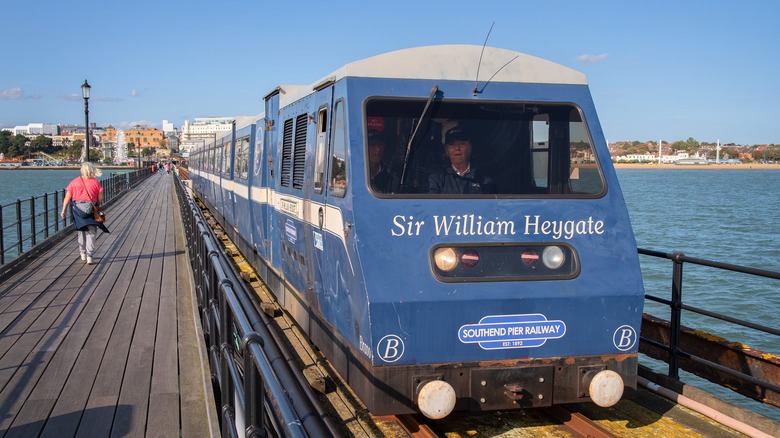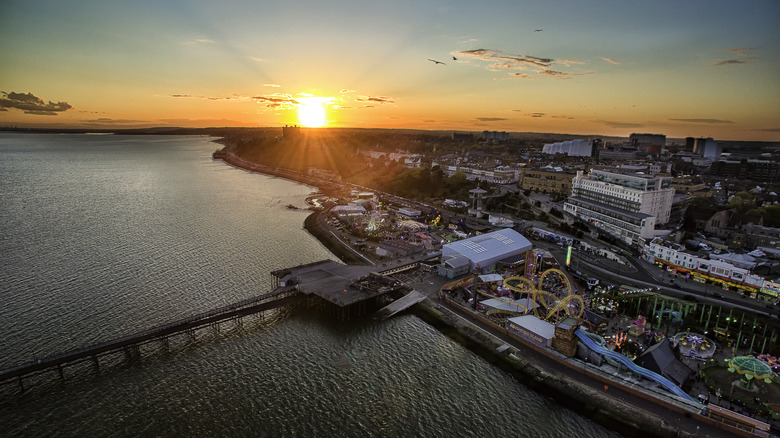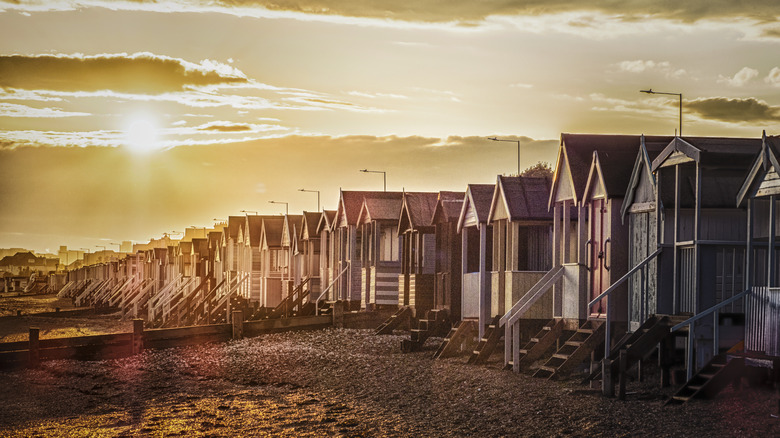This Unique Train Ride On The World's Longest Pleasure Pier Is A Scenic English Gem
It's an oft-quoted fact that you are never more than 70 miles from the coast in the United Kingdom, so it is only natural that people flock to the seaside to enjoy their downtime whenever they get the chance. Resort towns boomed in the mid-19th Century as vacationers left the grime of the cities to take a well-earned breath of fresh air. Amenities and attractions were built to provide fun and relaxation, giving rise to the grand old tradition of pleasure piers. By 1900, there were around 100 striking out from the English coastline, some stretching far out to sea. The world's longest can still be found at Southend-on-Sea in Essex.
Building super-long piers wasn't vanity for the Victorians; the increasingly ornate structures gave holidaymakers a chance to stay by the sea even as it retreated at low tide. Planners in Southend faced a specific challenge: Overlooking the shallow Thames Estuary, the sea recedes over a mile from shore. This caused a problem for the passenger boats carrying scores of eager vacationers, as they couldn't get close to the seafront when the tide was out.
The solution was to extend Southend's old wooden pier. By 1848, it was the longest in Europe, reaching 7,000 feet (1.3 miles). Increased footfall took its toll, and the town replaced it with a new iron structure and added an electric railway. There is still a modern version trundling along Southend pier today, and the scenic route is affectionately known as the "Train to Nowhere."
Southend Pier today
The Southend Pier has changed significantly over the decades, thanks to upgrades, new attractions, fortification by the Royal Navy during World War II, and a string of disastrous fires. In 1959, a blaze in the pavilion trapped 500 people on the pier before they were rescued by boat. The old pavilion has gone, as has the bowling alley that replaced it in 1962, and the new entrance is an unlovely, glass-and-steel construction. Nowadays, there isn't much to do on the pier itself other than a spot of fishing or a nice bracing stroll to the far end. It remains popular, however, winning the National Pier Society's "Pier of the Year" award in 2023.
If you want to get nowhere faster, you can take the train. Modern eco-friendly models replaced the old diesel locomotives that chugged up and down since the mid-1900s, unveiled by Prince Charles in 2022. Adult fares cost £7.50 return (approx. $9.50), and you can shave off a quid by taking the train one way and walking the other.
Once you reach the pier head, you can sit and gaze out across the estuary or look back at Southend in the distance. Activities are fairly limited, with a few basic amusements for the kids. Luckily, there are refreshments available. The Offshore Restaurant has taken residence in the striking Royal Pavilion, serving up fish and chips and other classics, while Tea with the Tide is a pleasant café with fresh cakes and drinks.
Other things to do in Southend-on-Sea
Southend-on-Sea has developed an unenviable name as one of the worst seaside towns in the U.K., ranked 12th out of the bottom 20 by the Telegraph in 2023. This reflects a general trend in recent years. English coastal resorts have fallen a long way since their post-war heyday, and modern vacationers tend toward cozy boutique destinations like Bamburgh Castle in Northumberland, while traditional names like Blackpool, Brighton, and Skegness get a bad reputation (though they are misjudged gems). This shouldn't put you off, however, because Southend is a classic seaside town with the same down-at-heel charm that you will find in many similar places around the U.K. coast.
The promenade is lined with chip shops, ice cream parlors, penny arcades, souvenir shops, and pubs and dotted with a few incongruous palm trees. Its focal point is still the pier, which is surrounded by the rides and attractions of Adventure Island. It is a free-to-enter funfair with a decent selection of rides, including rollercoasters, a Ferris wheel, and a ghost house. Southend also boasts 7 miles of sand and-or shingle beaches with colorful beach huts, which means it is easy to get a spot even when the summer crowds arrive. Four of the beaches were also awarded Blue Flags for cleanliness in 2023. Southend-on-Sea may not be posh, but it makes for a convenient day trip if you're staying in London. It also provides an interesting snapshot of the English seaside in the 21st Century.


